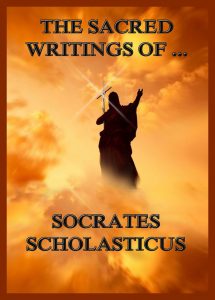The Sacred Writings of Socrates Scholasticus – Socrates Scholasticus
This work comprises the ‘Ecclesiastical History’. Until the beginning of the fourth century historiography remained a pagan science. With the exception of the Acts of the Apostles and its apocryphal imitations, no sort of attempt hadbeen made to record even the annals of the Christian Church. At the opening of the fourth century Eusebius conceived the idea of writing a history which should include a complete account of the Church’s life to his own days. Hence he has correctly been called the Father of Church History. His work was done so satisfactorily to his contemporaries and immediate successors that none of them undertook to go over the same field again. They estimated the thoroughness and accuracy of his work much higher than later ages have done. But this respect, which enhanced the magnitude of his work in their eyes, at the same time inspired many of them with a desire to imitate him. As the title of the work indicates, the subject is chiefly the vicissitudes and experiences of the Christian Church; but the author finds various reasons for interweaving with the account of ecclesiastical affairs some record also of the affairs of the state. His statement of these reasons puts first among them the relief his readers would experience by passing from the accounts of the perpetual wranglings of bishops to something of a different character; second, the information which all ought to have on secular as well as ecclesiastical matters; and third, the interlacing of these two lines, on account of which the understanding of the one cannot be full without some knowledge of the other.
Format: Paperback.
The Sacred Writings of Socrates Scholasticus
ISBN: 9783849673581.
Available at amazon.com and other venues.
The Historia Ecclesiastica (from wikipedia)
The history covers the years 305–439, and experts believe it was finished in 439 or soon thereafter, and certainly during the lifetime of Emperor Theodosius II, i.e., before 450. The purpose of the history is to continue the work of Eusebius of Caesarea . It relates in simple Greek language what the Church experienced from the days of Constantine to the writer’s time. Ecclesiastical dissensions occupy the foreground, for when the Church is at peace, there is nothing for the church historian to relate. In the preface to Book 5, Socrates defends dealing with Arianism and with political events in addition to writing about the church.
The Historia Ecclesiastica is one of the few sources of knowledge of Hypatia, the female mathematician and philosopher of Alexandria.
Socrates’ account is in many respects well-balanced. He is careful not to use hyperbolic titles when referring to prominent personalities in Church and State.
He is often assumed to have been a follower of Novatianism, but this is based on the fact that he gives a lot of details about the Novatianists, and speaks of them in generous terms, as he does of Arians and other groups. He speaks of himself as belonging to the Church.
Socrates asserts that he owed the impulse to write his work to a certain Theodorus, who is alluded to in the proemium to the second book as “a holy man of God” and seems therefore to have been a monk or one of the higher clergy. The contemporary historians Sozomen and Theodoret were combined with Socrates in a sixth-century compilation, which has obscured their differences until recently, when their individual portrayals of the series of Christian emperors were distinguished one from another and contrasted by Hartmut Leppin, Von Constantin dem Großen zu Theodosius II (Göttingen 1996).
(The text of the last section was taken from a Wikipedia entry and is available under the the Creative Commons Attribution-ShareAlike License.)
Publisher’s Note: This book is printed and distributed by Createspace a DBA of On-Demand Publishing LLC and is typically not available anywhere else than in stores owned and operated by Amazon or Createspace.

